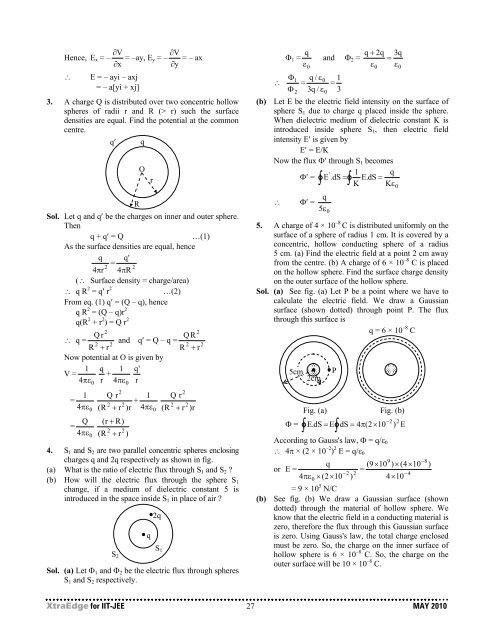You also want an ePaper? Increase the reach of your titles
YUMPU automatically turns print PDFs into web optimized ePapers that Google loves.
Hence, E x = –<br />
∴<br />
∂V<br />
∂ x<br />
E = – ayi – axj<br />
= – a[yi + xj]<br />
∂V<br />
= –ay, E y = –<br />
∂ y<br />
= – ax<br />
3. A charge Q is distributed over two concentric hollow<br />
spheres of radii r and R (> r) such the surface<br />
densities are equal. Find the potential at the common<br />
centre.<br />
q′ q<br />
O<br />
R<br />
Sol. Let q and q′ be the charges on inner and outer sphere.<br />
Then<br />
q + q′ = Q<br />
…(1)<br />
As the surface densities are equal, hence<br />
q q'<br />
=<br />
2 2<br />
4πr<br />
4πR<br />
(∴ Surface density = charge/area)<br />
∴ q R 2 = q′ r 2<br />
…(2)<br />
From eq. (1) q′ = (Q – q), hence<br />
q R 2 = (Q – q)r 2<br />
q(R 2 + r 2 ) = Q r 2<br />
2<br />
2<br />
Q r<br />
Q R<br />
∴ q = and q′ = Q – q =<br />
2 2<br />
2 2<br />
R + r<br />
R + r<br />
Now potential at O is given by<br />
1 q 1 q'<br />
V = +<br />
4πε0<br />
r 4πε0<br />
r<br />
=<br />
=<br />
1<br />
4πε<br />
0<br />
0<br />
2<br />
Q r 1<br />
+<br />
2 2<br />
(R + r ) r 4πε<br />
Q (r + R)<br />
2<br />
4πε (R r )<br />
2 +<br />
r<br />
0<br />
(R<br />
Q r<br />
2<br />
2<br />
2<br />
+ r ) r<br />
4. S 1 and S 2 are two parallel concentric spheres enclosing<br />
charges q and 2q respectively as shown in fig.<br />
(a) What is the ratio of electric flux through S 1 and S 2 ?<br />
(b) How will the electric flux through the sphere S 1<br />
change, if a medium of dielectric constant 5 is<br />
introduced in the space inside S 1 in place of air ?<br />
S 2<br />
Sol. (a) Let Φ 1 and Φ 2 be the electric flux through spheres<br />
S 1 and S 2 respectively.<br />
q<br />
2q<br />
S 1<br />
∴<br />
q<br />
Φ 1 =<br />
ε<br />
0<br />
q / ε<br />
Φ 1 =<br />
0<br />
Φ 2 3q / ε0<br />
and Φ 2 =<br />
= 3<br />
1<br />
q + 2q 3q<br />
=<br />
ε ε<br />
(b) Let E be the electric field intensity on the surface of<br />
sphere S 1 due to charge q placed inside the sphere.<br />
When dielectric medium of dielectric constant K is<br />
introduced inside sphere S 1 , then electric field<br />
intensity E′ is given by<br />
E′ = E/K<br />
Now the flux Φ′ through S 1 becomes<br />
' 1 q<br />
Φ′ =<br />
∫<br />
E .dS =<br />
∫<br />
E.dS =<br />
K Kε<br />
∴ Φ′ =<br />
q<br />
5ε<br />
0<br />
5. A charge of 4 × 10 –8 C is distributed uniformly on the<br />
surface of a sphere of radius 1 cm. It is covered by a<br />
concentric, hollow conducting sphere of a radius<br />
5 cm. (a) Find the electric field at a point 2 cm away<br />
from the centre. (b) A charge of 6 × 10 –8 C is placed<br />
on the hollow sphere. Find the surface charge density<br />
on the outer surface of the hollow sphere.<br />
Sol. (a) See fig. (a) Let P be a point where we have to<br />
calculate the electric field. We draw a Gaussian<br />
surface (shown dotted) through point P. The flux<br />
through this surface is<br />
q = 6 × 10 –8 C<br />
5cm<br />
Φ =<br />
2cm<br />
P<br />
Fig. (a) Fig. (b)<br />
∫<br />
∫<br />
E.dS = E dS = 4π(2×<br />
10 ) E<br />
0<br />
0<br />
0<br />
−2<br />
2<br />
According to Gauss's law, Φ = q/ε 0<br />
∴ 4π × (2 × 10 –2 ) 2 E = q/ε 0<br />
9<br />
−8<br />
q (9×<br />
10 ) × (4×<br />
10 )<br />
or E =<br />
=<br />
−2<br />
2<br />
−4<br />
4πε0 × (2×<br />
10 ) 4×<br />
10<br />
= 9 × 10 5 N/C<br />
(b) See fig. (b) We draw a Gaussian surface (shown<br />
dotted) through the material of hollow sphere. We<br />
know that the electric field in a conducting material is<br />
zero, therefore the flux through this Gaussian surface<br />
is zero. Using Gauss's law, the total charge enclosed<br />
must be zero. So, the charge on the inner surface of<br />
hollow sphere is 6 × 10 –8 C. So, the charge on the<br />
outer surface will be 10 × 10 –8 C.<br />
XtraEdge for <strong>IIT</strong>-<strong>JEE</strong> 27 MAY 2010

















